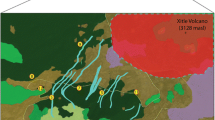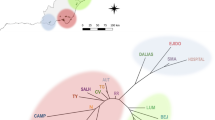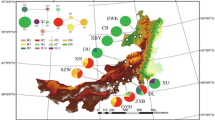Abstract
Acacia caven is a South American species which shows remarkable climate tolerance and ecological adaptability; as such, this species is suitable for colonizing anthropogenically degraded sites. This species is widely distributed, and six varieties have been described based on both morphological traits and molecular markers. Moreover, Aronson (1992) suggests that, for this species, geographical separation could be associated with ecological differentiation. In this study, amplified fragment length polymorphisms were used to study genetic variation within and among 15 populations of A. caven from five eco-regions of Argentina and to investigate (1) whether the varieties are genetically coherent, (2) whether the varieties correspond consistently to a single eco-region, (3) the proportion of the species diversity explained within and among varieties and eco-regions. Eight of the 225 bands appear to be under positive selection. The remaining 217 neutral loci showed a high percentage of polymorphism (99.1%). The estimates of genetic diversity H j were generally high. The F ST (0.315) was highly significant, providing evidence for genetic structure among populations. Hierarchical analysis of molecular variance indicated that variation among eco-regions was 8.2% and highly significant. The higher component of variance was found within populations (67.5%). STRUCTURE analysis suggested that the optimal number of K = 11. The results showed that, in most cases, geographic separation is associated with ecological differentiation. Since differentiation of A. caven populations studied here in eco-regions was highly significant, sampling should include a large number of trees within populations as well as covering the wide ecological diversity of the species.




Similar content being viewed by others
References
Allen ON, Allen EK (1981) The Leguminosae. A source book of characteristics, uses and nodulation. University of Wisconsin, Madison, Wisconsin
Antao T, Beaumont MA (2011) Mcheza: a workbench to detect selection using dominant markers. Bioinformatics 27(12):1717–1718. doi:1093/bioinformatics/btr253
Aronson J (1992) Evolutionary biology of Acacia caven (Leguminosae, Mimosoideae): infraspecific variation in fruit and seed characters. Ann Mo Bot Gard 79:958–968
Avise JC, Hamrick JL (1996) Conservation genetics, case histories from nature. Chapman and Hall, New York, pp 1–9
Bassam BJ, Caetano-Anollés G, Greshoff PM (1991) Fast and sensitive silver staining of DNA in polyacrylamide gels. Anal Biochem 196:81–84
Bensch S, Akesson M (2005) Ten years of AFLP in ecology and evolution: why so few animals? Mol Ecol 14:2899–2914
Bentham G (1842) Notes on Mimosae, with a synopsis of species. Lond J Bot 1(318–392):494–528
Bentham G (1875) Revision of the suborder Mimosae. Trans Linn Soc Lond 30:335–664
Bernhardt P, Kenrick J, Knox RB (1984) Pollination biology and the breeding system of Acacia retinodes (Leguminosae: Mimosoideae). Ann Mo Bot Gard 71:17–29
Bonin A, Ehrich D, Manel S (2007) Statistical analysis of amplified fragment length polymorphism data: a toolbox for molecular ecologists and evolutionists. Mol Ecol 16:3737–3758
Brown A, Martinez Ortiz U, Acerbi M, Corcuera J (eds) (2006) La Situación Ambiental Argentina 2005. Fundación Vida Silvestre Argentina, Buenos Aires
Burkart R, Bárbaro NO, Sánchez RO, Gómez DA (1999) Ecorregiones de la Argentina. Administración de Parques Nacionales, Buenos Aires
Butcher PA, Moran GF, Perkins HD (1998) RFLP diversity in the nuclear genome of Acacia mangium. Heredity 81:205–213
Cabrera AL (1976) Regiones fitogeograficas Argentinas. In: Ferreira Sobral EF (ed) Enciclopedia Argentina de Agricultura y Jardinería. ACME, Buenos Aires, Argentina, pp. 1–85
Casiva PV, Vilardi JC, Cialdella AM, Saidman BO (2004) Mating system and population structure of Acacia aroma and A. macracantha (Fabaceae). Am J Bot 91(1):58–64
Chiveu Chemulanga J, Dangasuk OG, Omunyin ME, Wachira FN (2008) Genetic diversity in Kenyan populations of Acacia senegal (L.) Willd revealed by combined RAPD and ISSR markers. Afr J Biotechnol 7(14):2333–2340
Cialdella AM (1984) El género Acacia (Leguminosae) en la Argentina. Darwiniana 25(1–4: 59-11, f. 1–8)
Dyer RJ (2008) GeneticStudio: population genetic software that doesn’t suck. http://dyerlab.bio.vcu.edu
Dyer RJ, Westfall RW, Sork VL, Smouse PE (2004) Two-generation analysis of pollen flow across a landscape V: a stepwise approach for extracting factors contributing to pollen structure. Heredity 92(3):204–211
Excoffier L, Smouse P, Quattro J (1992) Analysis of molecular variance inferred from metric distances among DNA haplotypes: application to human mitochondrial DNA restriction data. Genetics 131:479–491
Fernández OA, Russo CA (1997) Arid and semi-arid rangelands: two thirds of Argentina. Rala report N0 200, p 20
Francisco-Ortega J, Santos-Guerra A, Kim SC, Crawford DJ (2000) Plant genetic diversity in the Canary Islands: a conservation perspective. Am J Bot 87:909–919
Frankel OH, Brown AHD, Burdon JJ (1995) The conservation of plant biodiversity. Cambridge University Press, Cambridge
Guinet P, Vassal J (1978) Hypotheses on the differentiation of the major groups in the genus Acacia (Leguminosae). Kew Bull 32:509–527
Hamrick JL (1983) The distribution of genetic variation within and among natural plant populations. In: Schonewald-Cox CM, Chambers SM, McBryde B, Thomas WL (eds) Genetics and conservation. Benjamin/Cummings, Menlo Park, California, pp 335–348
Hamrick JC, Godt JW (1990) Allozyme diversity in plant species. In: Brown HD, Clegg MT, Kahler AL, Weir BS (eds) Plant population genetics, breeding, and genetic resources, 43–65. Sinauer Associates, Sunderland, Massachusetts
Hamrick JL, Godt MJW (1996) Conservation genetics of endemic plant species. In: Avise JC, Hamrick JL (eds) Conservation genetics. Chapman & Hall, New York, pp 281–304
Holsinger KE, Lewis PO (2007) Hickory: a package for analysis of population genetic data V1.1. Department of Ecology and Evolutionary Biology, University of Connecticut, Storrs, CT, USA
Jakobsson M, Rosenberg NA (2007) CLUMPP: a cluster matching and permutation program for dealing with label switching and multimodality in analysis of population structure. Bioinformatics 23:1801–1806
Joly HI, Zeh-Nlo A, Danthu P, Aygalent C (1992) Population genetics of an African Acacia, Acacia albida. I. Genetic diversity of populations from West Africa. Aust J Bot 40:59–73
Karlin OU, Coirini RO, Catalan L, Zapata R (1997) Acacia caven. In: Oficina Regional de la FAO para America Latina y el Caribe [ed.], Especies arbóreas y arbustivas para las zonas áridas y semiáridas de América Latina, 157–167. Zonas áridas y semiáridas, 12. FAO/PNUMA, Santiago, Chile
Kenrick J, Knox RB (1985) Self-incompatibility in the nitrogen-fixing tree, Acacia retinodes: quantitative cytology of pollen tube growth. Theor Appl Genet 69:481–488
Kenrick J, Kaul V, Williams EG (1986) Self-incompatibility in Acacia retinodes: site of pollen-tube arrest in the nucellus. Planta 169:245–250
Luckow M (2005) Tribe Mimoseae. In: G. Lewis et al. (eds) Legumes of the world. Royal Botanical Gardens: Kew; 163–183
Luikart G, England PR, Tallmon D, Jordan S, Taberlet P (2003) The power and promise of population genomics: from genotyping to genome typing. Nature 4:981–994
Lynch M, Milligan BG (1994) Analysis of population structure with RAPD markers. Mol Ecol 3:91–99
McDonald MW, Maslin BR (2000) Taxonomic revision of the salwoods: Acacia aulacocarpa Cunn. Ex. Benth; and its allies (Leguminosae: Mimosoideae: section juliflorae). Aust Syst Bot 13:21–78
McDonald MW, Buther PA, Bell JC, Nguyen CV (2003) Clinal variation and genetic divergence in Acacia tumida (Mimosaceae). Austr Syst Bot 16:57–67
McGranahan M, Bell JC, Moran GF, Slee M (1997) High genetic divergence between geographic regions in the highly out crossing species Acacia aulacocarpa (Cunn. Ex Benth.). For Genet 4:1–13
Moran GF, Muona O, Bell JC (1989) Breeding systems and genetic diversity in Acacia auriculiformis and Acacia crassicarpa. Biotropica 21:250–256
Mueller UG, Wolfenbarger LL (1999) AFLP genotyping and fingerprinting. Trends Ecol Evol 14:389–394
Nei M (1973) Analysis of gene diversity in subdivided populations. Proc Natl Acad Sci USA 70:3321–3323
Nei M (1978) Estimation of average heterozygosity and genetic distance from a small number of individuals. Genetics 89:583–590
Nybom H (2004) Comparison of different nuclear DNA markers for estimating intraspecific genetic diversity in plants. Mol Ecol 13:1143–1155
Omondi SF, Kireger E, Dangasuk OG, Chikamai B, Odee DW, Cavers S, Khasa DP (2010) Genetic diversity and population structure of Acacia senegal (L) Willd in Kenya. Tropical Plant Biology 3:59–70
Polhill RM, Raven PH, Stirton CH (1981) Evolution and systematics of the Leguminosae: 1-26. In: Polhill RM, Raven PH (eds) Advances in legumes systematics, vol. 1. Royal Botanic Gardens, Kew
Pometti CL, Cialdella AM, Vilardi JC, Saidman BO (2007) Morphometric analysis of varieties of Acacia caven: (Leguminosae, Mimosoideae): taxonomic inferences in the context of other Argentinean species. Plant Syst Evol 264:239–249
Pometti CL, Vilardi JC, Cialdella AM, Saidman BO (2010) Genetic diversity among the six varieties of Acacia caven (Leguminosae, Mimosoideae) evaluated at molecular and phenotypic levels. Plant Syst Evol 284:187–199. doi:10.1007/s00606-009-0244-y
Pometti CL, Vilardi JC, Saidman BO (2011) Mating system parameters and genetic structure in Argentinean populations of Acacia caven (Leguminosae, Mimosoideae). Plant Syst Evol 292:25–32. doi:10.1007/s00606-010-0389-8
Pritchard JK, Stephens M, Donnelly P (2000) Inference of population structure using multilocus genotype data. Genetics 155:945–959
Pritchard JK, Wen X, Falush D (2009) STRUCTURE ver. 2.3. University of Chicago, Chicago, USA http://pritch.bsd.uchicago.edu/
Raymond M, Rousset F (1995) GENEPOP (version 1.2): population genetics software for exact tests and ecumenicism. J Hered 86:248–249
Rosenberg NA (2004) Distruct: a program for the graphical display of population structure. Mol Ecol Notes 4:137–138
Ross JH (1981) An analysis of the African Acacia species: their distribution, possible origins and relationships. Bothalia 13:389–413
Saidman BO, Vilardi JC (1993) Genetic variability and germplasm conservation in the genus Prosopis, 187-198. In: Puri S (ed) Nursery technology of forest tree species of arid and semiarid regions. Winrock-Oxford & IBH Publishing Co. PVT. Ltd, New Delhi, Bombay, Calcutta
Sedgley M, Harbard J, Smith R-M, Wickneswari R, Griffin AR (1992) Reproductive biology and interspecific hybridization of Acacia mangium and A. auriculiformis A. Cunn. ex Benth. (Leguminosae: Mimosoideae). Aust J Bot 40:37–48
Shrestha MK, Golan-Goldhirsh A, Ward D (2002) Population genetic structure and the conservation of isolated populations of Acacia raddiana in the Negev Desert. Biol Conserv 108:119–127
Statsoft INC. (2000) STATISTICA for Windows 5.5 (Computer Program Manual). Tulsa O. K.: StatSoft, Inc., 2300 East 14th Street, Tulsa O. K., 74104-4442, (918)749–1119
Vassal J (1972) Apport des recherches ontogéniques et séminologiques a l’étude morphologique, taxonomique et phylogénique du genre Acacia. Bulletin de la Societé d’Histoire Naturelle de Toulouse 108:1–115
Vekemans X (2002) AFLP-SURV version 1.0. Distributed by the author. Laboratoire de Génétique et Ecologie Végétale, Université Libre de Bruxelles, Belgium
Vilardi JC, Saidman BO, Palacios RA (1988) Muestreo según variabilidad, 119–124, In: Prosopis en Argentina. Documento preliminar elaborado para el I Taller Internacional sobre Recurso genético y conservación de germoplasma en Prosopis. Fac. de Cs. Agropecuarias, UNC-FAO, PIRB
Vos R, Hogers R, Bleeker M, Reijans M, Lee T, Hornes M et al (1995) AFLP: a new technique for DNA fingerprinting. Nucleic Acids Res 23:4407–4414
Wickenesswari R, Norwati M (1993) Genetic diversity of natural populations of Acacia auriculiformis. Aust J Bot 41:65–77
Wright S (1943) Isolation by distance. Genetics 28(2):114–138
Wright S (1978) Evolution and the genetics of populations variability within and among natural populations, vol. 4. University of Chicago Press, Chicago
Zhivotovsky LA (1999) Estimating population structure in diploids with multilocus dominant DNA markers. Mol Ecol 8:907–913
Acknowledgments
The authors of this work want to thank Dra. Ana María Cialdella of Instituto de Botánica Darwinion, who kindly determined the material studied here. This work was supported by the Universidad de Buenos Aires (EX201 and 20020100100008 to B. O. S.) and the Consejo Nacional de Investigaciones Científicas y Técnicas (PIP 11220090100147 to J. C. V.).
Ethical standards
In order to fulfill the objectives proposed, the experiments conducted comply with the current Argentine laws and all the trials were made without disturbing the natural ecosystem taking into consideration the current legislation in the country. For the experimental laboratory practice done at Facultad de Ciencias Exactas y Naturales (Universidad de Buenos Aires), we followed the recommendations from Servicio de Higiene y Seguridad (SHyS, FCEyN, UBA).
Conflict of interest
The authors declare that they have no conflict of interest.
Author information
Authors and Affiliations
Corresponding author
Additional information
Communicated by G. G. Vendramin
Rights and permissions
About this article
Cite this article
Pometti, C.L., Bessega, C.F., Vilardi, J.C. et al. Landscape genetic structure of natural populations of Acacia caven in Argentina. Tree Genetics & Genomes 8, 911–924 (2012). https://doi.org/10.1007/s11295-012-0479-6
Received:
Revised:
Accepted:
Published:
Issue Date:
DOI: https://doi.org/10.1007/s11295-012-0479-6




